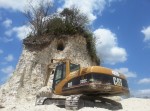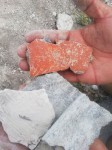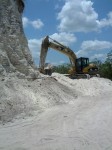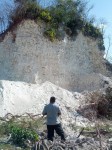 Last week, archaeologists from the National Institute of Culture and History’s Institute of Archaeology were called to the site of main temple at the Nohmul complex in northern Belize after learning that heavy equipment was damaging the 2,300-year-old structure. They arrived to find the onetime pyramid, turned by time into an overgrown mound about 100 feet tall, had been brutally whittled away by backhoes. Dump trucks were on site to carry out the limestone bricks, each one carved by hand with stone age tools by ancient Mayans, which apparently make good rubble for road fill.
Last week, archaeologists from the National Institute of Culture and History’s Institute of Archaeology were called to the site of main temple at the Nohmul complex in northern Belize after learning that heavy equipment was damaging the 2,300-year-old structure. They arrived to find the onetime pyramid, turned by time into an overgrown mound about 100 feet tall, had been brutally whittled away by backhoes. Dump trucks were on site to carry out the limestone bricks, each one carved by hand with stone age tools by ancient Mayans, which apparently make good rubble for road fill.
Nohmul is one of only four important pre-classic Mayan sites in northern Belize and its central temple and namesake (Noh Mul means “big hill”) is one of the tallest in the country. The entire complex covers an area of about 12 square miles in the middle of sugar cane fields. There are 81 buildings, all of them mounds today, which were home to an estimated 40,000 people between 500 and 250 B.C. The main temple, in addition to having a public ceremonial and administrative function, may have also housed the High Priest or important nobles. You can see one of several chambers the Maya built into the structure torn open at the top edge of the destruction. Archaeologists found fragments of monochrome pottery typical of the pre-classic period all over the mangled site.
 All of the buildings are on private property, but they are protected by law as ancient monuments. Unfortunately, the statutory protection does not stop unscrupulous fiends from using them as gravel quarries. As Dr. Allan Moore from the Institute of Archaeology put it in a local 7News story, “Belize is 8,867 square miles of jungle. We are only around 16 personnel in the department. We can’t be in the Chiquibul and at the same time being at La Milpa.” They have to rely on tip-offs, and by the time they respond, it’s often too late.
All of the buildings are on private property, but they are protected by law as ancient monuments. Unfortunately, the statutory protection does not stop unscrupulous fiends from using them as gravel quarries. As Dr. Allan Moore from the Institute of Archaeology put it in a local 7News story, “Belize is 8,867 square miles of jungle. We are only around 16 personnel in the department. We can’t be in the Chiquibul and at the same time being at La Milpa.” They have to rely on tip-offs, and by the time they respond, it’s often too late.
The construction companies are well aware of the advantage this paltry ratio of enforcers to surface area confers. There are tens of thousands Mayan mounds dotting the landscape; gutting them for use as rubble has become an endemic problem. This is a deliberate choice made by the builders. Although the mounds look like hills covered in plant growth rather than the clean pyramids we associate with Maya architecture, they are very well known as Maya structures. It’s not like the construction companies innocently think they’re clawing away at a hill only to find a wealth of limestone bricking. It’s the bricks they’re targeting.
 The construction company in this case was identified. Archaeologists saw the name of D-Mar Construction on the equipment, a company owned by one Denny Grijalva, a United Democratic Party candidate for representative of his district, Orange Walk Central. Nohmul is in Orange Walk North. Interesting that the party platform includes rebuilding access roads to major tourist sites. It would seem counterproductive to build those roads using the major tourist sites. Then again, following election laws appears to be a sore point for Mr. Gijalva, so what’s a little cultural patrimony destruction?
The construction company in this case was identified. Archaeologists saw the name of D-Mar Construction on the equipment, a company owned by one Denny Grijalva, a United Democratic Party candidate for representative of his district, Orange Walk Central. Nohmul is in Orange Walk North. Interesting that the party platform includes rebuilding access roads to major tourist sites. It would seem counterproductive to build those roads using the major tourist sites. Then again, following election laws appears to be a sore point for Mr. Gijalva, so what’s a little cultural patrimony destruction?
When questioned by the 7News team, Grijalva denied knowing anything about his backhoes tearing down an ancient Mayan temple in the district next to the one he is running to represent.
Grijalva … referred us to his foreman who never answered at least a dozen calls we made to him. Then Grijalva said he would be there in twenty minutes, we waited fourty and left – we had been stood up.
Interestingly, Grijalva told us that when his foreman got there, he would apologize on behalf of the company, D-Mar’s and the Deputy Prime Minister, Gaspar Vega. Vega’s name comes in because Noh Mul is in Orange Walk North, and the roadfill is reportedly being used in nearby Douglas Village. Of course, we never met the foreman, but we have learned that after we left with the Archeologists, he did arrive and removed the heavy equipment.
 How giving of them to remove their means of illegal demolition once the archaeological authorities and police were on site. Police are now investigating the temple destruction. Let’s hope there are real consequences — ie, prison — for Grijalva and anyone else who was in on this monstrosity.
How giving of them to remove their means of illegal demolition once the archaeological authorities and police were on site. Police are now investigating the temple destruction. Let’s hope there are real consequences — ie, prison — for Grijalva and anyone else who was in on this monstrosity.
As for the temple itself, there is no way to restore it. There’s just too little of it left. Archaeologists expect it to lose all structural integrity and collapse when the rains come.